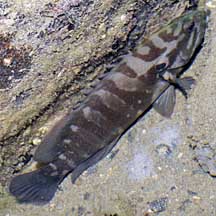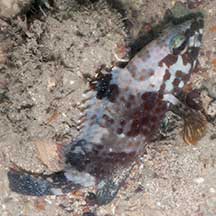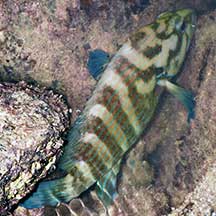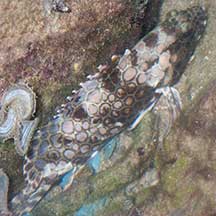 |
|
| fishes text index | photo index |
| Phylum Chordata > Subphylum Vertebrata > fishes |
| Groupers Family Serranidae updated Oct 2020
Where seen? Groupers are sometimes seen on some of our shores. At low tide, they may be stranded in pools or hiding under large chunks of coral rubble. Juveniles are common in muddy, sandy river mouths and among mangroves. Adults found in reefs as solitary carnivores. Small groupers are sometimes encountered on our shores at low tide. Do leave them alone, so they can grow bigger and perhaps one day we can enjoy them in a different way. What are groupers? Groupers belong to the Family Serranidae. According to FishBase: the family has 62 genera and 449 species, found in tropical and temperate seas, with some entering freshwater. They range from small fishes a few centimeters long as adults, to giants 3m long. Features: Groupers come in various shapes and colours and patterns. Generally, they have large mouths. Groupers are among the top predators in calm, shallow waters. They hunt alone, and either creep up on their prey or lie in ambush. They suck in prey by suddenly opening their huge mouths. Groupers have sharp, spiky teeth. These merely grip and don't kill, so the prey is usually swallowed alive! Grouper babies: Members of the Family Serranidae can change their gender! Most are female when they first reach maturity. As they get larger, some may change into males. Some groupers gather in large aggregations at a particular place to spawn. Such aggregation sites are often the part of a reef with strong currents that wash the fertilised eggs out to sea, to develop away from hungry filter-feeders. Human uses: Groupers are edible and a highly valued seafood dish for many Singaporeans. However, we may be eating the groupers to extinction. Groupers are vulnerable to overfishing because they are not numerous to begin with. At the same time, they have high commercial value and are relatively easy to catch. Many are territorial and stay within a particular home range, and most are not shy of divers. In the Hong Kong area, populations of the larger groupers are dwindling and smaller groupers such as the Chocolate hind (Cephalopholis boenak) are now being targetted. Being top predators, they are naturally uncommon. They reach maturity and maximum size relatively slowly. Thus overfishing of young fish before they are able to reproduce can have a serious effect. Males are larger and rarer, thus more vulnerable to overfishing. This can result in an imbalance in the gender ratio which can affect reproduction. Overfishing at the spawning sites where large numbers of the usually solitary groupers gather can also devastate the local population of these fishes. In Southeast Asia, groupers are widely farmed in floating cages or in ponds and tanks. In Singapore, some like the Orange-spotted grouper (Epinephalus coioides) and Malabar grouper (Epinephelus malabaricus) are reared in floating cages in the sea until they reach marketable size. However, the farms are mostly stocked by juveniles harvested unsustainably from the wild. |
| Some Groupers on Singapore shores |
| Unidentified groupers on Singapore shores |
| Photos of Unidentified groupers for free download from wildsingapore flickr |
| Family
Serranidae recorded for Singapore from Wee Y.C. and Peter K. L. Ng. 1994. A First Look at Biodiversity in Singapore. *from from Tan, K. S. & L. M. Chou, 2000. A Guide to the Common Seashells of Singapore. **from WORMS +Other additions (Singapore Biodiversity Record, etc)
|
Links
References
|



